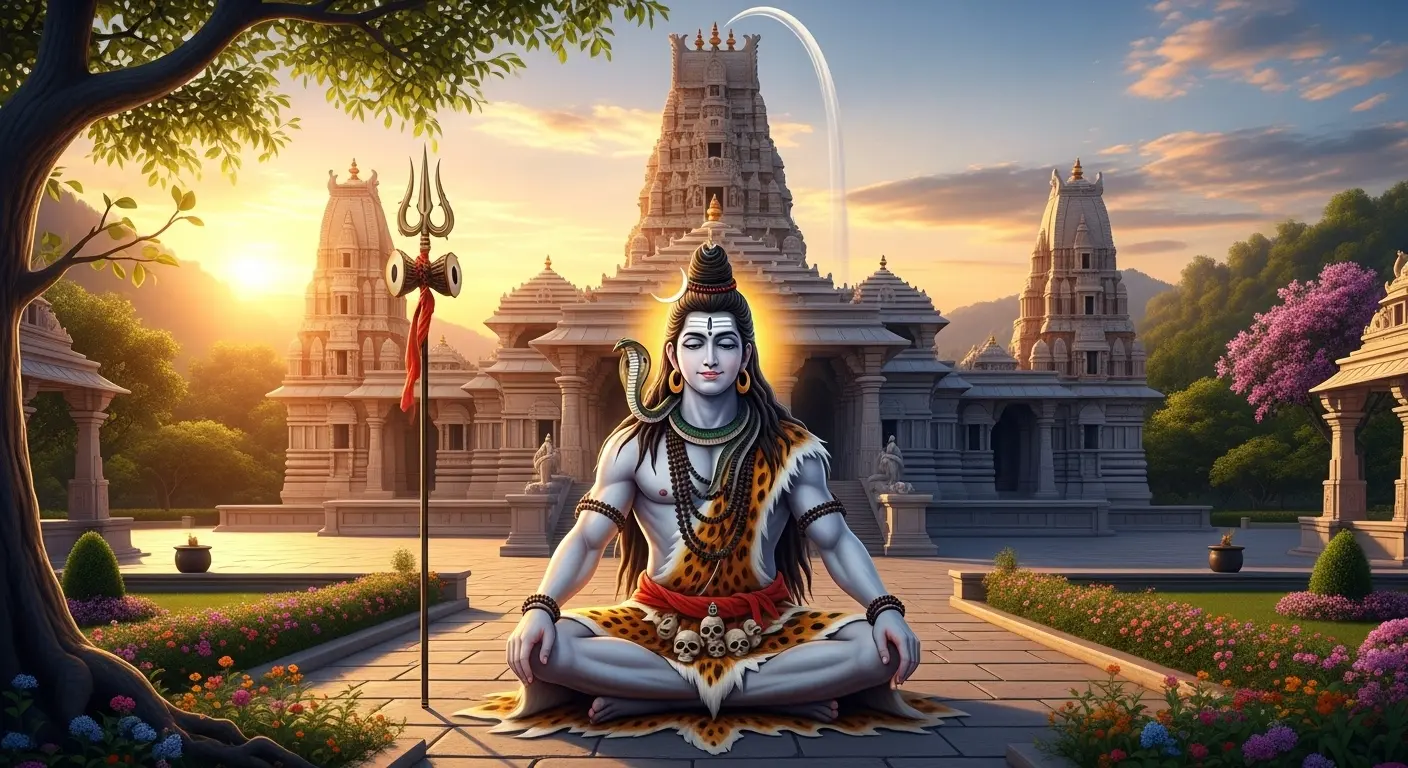North India is studded with holy shrines of Lord Shiva, one of the primary gods of Hindu religion referred to as the destroyer of evil and the transformer. Pilgrims and visitors from all walks of life seek blessings at these holy temples, many of which are of great mythological and spiritual importance.
Whether you’re traveling on a religious quest or seeking India’s rich cultural heritage, here are 10 North India must-see Shiva temples every pilgrim and traveler must experience.
1. Kashi Vishwanath Temple – Varanasi, Uttar Pradesh
One of the 12 Jyotirlingas, Kashi Vishwanath is one of the holiest and most frequented Shiva temples. It stands on the Ganga banks in Varanasi, and it is said that visiting here brings moksha (liberation).
Why Famous:
It’s one of the most revered Jyotirlingas, drawing millions seeking spiritual liberation (moksha) and is central to the ancient spiritual fabric of Varanasi.
Highlight:
- Ancient temple, sunset Ganga aarti, and strong spiritual energies.
Places to Visit Nearby:
- Dashashwamedh Ghat: Witness the iconic Ganga Aarti.
- Assi Ghat: Popular for sunrise boat rides and cultural activities.
- Sarnath: Where Buddha delivered his first sermon (approx. 10 km).
- Ramnagar Fort: Historic residence of the Kashi Naresh.
2. Kedarnath Temple – Uttarakhand
Located in the Himalayas at 11,755 feet, Kedarnath is another of the 12 Jyotirlingas. Climbing to the temple involves a trek or helicopter, but divine energy and stunning scenery ensure a memorable experience.
Why Famous:
A pivotal part of the Char Dham and Panch Kedar pilgrimages, known for its extreme altitude and the challenging yet rewarding journey to reach it, embodying deep penance.
Highlight:
- Glacial setting, pilgrim ambiance, and one of the Char Dham temples.
Places to Visit Nearby:
- Bhairavnath Temple: Dedicated to Lord Bhairav, guardian deity of Kedarnath.
- Gandhi Sarovar: A small lake near the temple, believed to be where Yudhishthira ascended to heaven.
- Vasuki Tal: A high-altitude lake offering stunning views (requires further trek).
- Sonprayag & Triyuginarayan Temple: Key stops on the route, Triyuginarayan is where Shiva and Parvati are believed to have married.
3. Amarnath Cave Temple – Jammu & Kashmir
A Shivling naturally formed in a cave at 12,756 feet, the temple remains open during summer months only for the once-a-year Amarnath Yatra. It’s one of India’s most revered and arduous pilgrimages.
Why Famous:
Known for the miraculous natural formation of an ice Shivling, making it one of the most challenging and spiritually significant annual pilgrimages in India.
Highlight:
- Spiritual quest, white-sapped mountains, and intense devotion.
Places to Visit Nearby:
- Pahalgam & Baltal: These serve as the main base camps for the arduous Amarnath Yatra.
- Lidder Valley (from Pahalgam): Offers scenic landscapes, trekking routes, and opportunities for relaxation.
4. Mahakaleshwar Temple – Ujjain, Madhya Pradesh
While geographically situated in the middle, it is culturally affiliated with North India. This Jyotirlinga is renowned for its Bhasma Aarti, when Lord Shiva is blessed with sacred ash very early in the morning.
Why Famous:
One of the 12 Jyotirlingas, uniquely famous for its powerful and ancient ‘Bhasma Aarti’ ritual, performed with ash from a freshly cremated body, symbolizing life and death.
Highlight:
- Midnight vigour, ancient mythologies, and mystical rituals.
Places to Visit Nearby:
- Kal Bhairav Temple: Dedicated to the fierce manifestation of Shiva, known for offering liquor to the deity.
- Harsiddhi Temple: One of the Shakti Peeths, dedicated to Goddess Harsiddhi.
- Ram Ghat: A sacred bathing ghat on the Shipra River, famous for the Kumbh Mela.
- Sandipani Ashram: Where Lord Krishna, Balarama, and Sudama received their education.
5. Neelkanth Mahadev Temple – Rishikesh, Uttarakhand
Situated among dense forests and valleys, it is the site where Lord Shiva consumed the poison during Samudra Manthan. A serene oasis with a high spiritual vibe.
Why Famous:
Revered as the sacred spot where Lord Shiva consumed the ‘Halahala’ poison churned during Samudra Manthan, turning his throat blue (Neelkanth).
Highlight:
- Picturesque forest hike, spiritual tranquility, and colorful Sawan festivities.
Places to Visit Nearby:
- Ram Jhula & Lakshman Jhula: Iconic suspension bridges offering scenic views and access to ashrams.
- Triveni Ghat: A sacred confluence for Ganga Aarti and holy dips.
- Parmarth Niketan Ashram: Known for its Ganga Aarti and yoga programs.
- The Beatles Ashram (Maharishi Mahesh Yogi Ashram): Famous for its association with the Beatles.
- Adventure Sports: Rishikesh is a hub for river rafting, bungee jumping, and trekking.
6. Baijnath Temple – Himachal Pradesh
In Kangra Valley, this finely carved stone temple is a shrine to Lord Vaidyanath (another name of Shiva). It’s more than 1,000 years old and a peaceful, serene destination far from the masses.
Why Famous:
An ancient (over 1000 years old) Lord Shiva temple renowned for its exquisite Nagara-style architecture and its peaceful setting in the scenic Kangra Valley.
Highlight:
- Ancient architecture and tranquil Himalayan landscape.
Places to Visit Nearby:
- Palampur: Known as the ‘Tea Capital of North India’, offering lush tea gardens.
- Bir Billing: A world-renowned destination for paragliding.
- Kangra Fort: One of the oldest and largest forts in the Himalayas.
- Dharamshala & McLeod Ganj: Home to the Dalai Lama and Tibetan culture (approx. 60-70 km).
7. Shiv Khori – Reasi, Jammu
A naturally occurring cave shrine where the Shivling is formed naturally within a constricted limestone cave. It attracts thousands of pilgrims every year, particularly during Shivratri.
Why Famous:
A unique natural cave shrine housing a self-manifested Shivling, known for its challenging narrow passages leading to the inner sanctum.
Highlight:
- Thrill-filled cave darshan and intense energy.
Places to Visit Nearby:
- Vaishno Devi Temple (Katra): One of India’s most visited pilgrimage sites, a short drive away.
- Bhimgarh Fort (Reasi): An ancient fort offering historical insights and views.
- Salal Dam: A large hydroelectric power project on the Chenab River.
8. Tungnath Temple – Uttarakhand
Tungnath at 3,680 meters is the world’s highest Shiva temple. It’s one of the Panch Kedar pilgrimages and has beautiful vistas of the Garhwal Himalayas.
Why Famous:
Holds the distinction of being the world’s highest Shiva temple and is a vital part of the Panch Kedar pilgrimage circuit, offering unparalleled Himalayan views.
Highlight:
- Scenic trek, lesser crowd, and divine silence.
Places to Visit Nearby:
- Chandrashila Peak: A further trek from Tungnath, offering spectacular 360-degree panoramic views of the Himalayan peaks.
- Chopta: The picturesque base camp for the Tungnath trek, known as ‘Mini Switzerland’.
- Deoria Tal: A serene lake offering stunning reflections of Chaukhamba peaks (requires a separate trek).
9. Gauri Kund – Uttarakhand
Along the road to Kedarnath, it is said that Goddess Parvati meditated here in order to win Shiva’s love. It is both a mythological and spiritual location.
Why Famous:
Revered as the place where Goddess Parvati performed penance to win Lord Shiva’s affection, and known for its hot springs.
Highlight:
- Mythology, hot springs, and picturesque rest stop.
Places to Visit Nearby:
- Sonprayag: The confluence point and a key base for the Kedarnath pilgrimage, where pilgrims often take a holy dip.
- Kedarnath Trek Route: Gauri Kund is the traditional starting point for the trek to Kedarnath, making it a crucial stop for pilgrims.
10. Agasteshwar Mahadev Temple – Rudraprayag, Uttarakhand
Just off the holy Alaknanda and Mandakini river confluence, this lesser-promoted but strong temple is connected to Sage Agastya and is a peaceful spiritual retreat.
Why Famous:
An ancient and serene temple believed to be the meditation spot of Sage Agastya, offering a peaceful spiritual retreat at a sacred river confluence.
Highlight:
- Riverside tranquility, ancient heritage, and a hidden treasure feel.
Places to Visit Nearby:
- Rudraprayag Confluence: Witness the sacred meeting point of the Alaknanda and Mandakini rivers.
- Koteshwar Mahadev Temple: A cave temple dedicated to Lord Shiva near Rudraprayag.
- Kartik Swami Temple: A unique temple dedicated to Lord Kartikeya, requiring a trek and offering stunning views.
Conclusion
From snow-covered Himalayan shrines to old riverbank temples, North India provides a memorable trip through the center of Shaivite spirituality. Each of these temples is not merely an edifice but a gateway of divine energy, history, and inner peace.
Whether you are a pilgrim or an inquisitive traveler, a visit to these Shiva temples will provide you with spiritual uplift and natural scenery that truly leaves a lasting impression.







